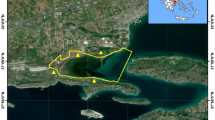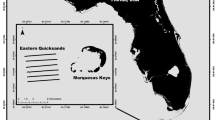Abstract
Northeastern Bristol Bay, Alaska, which includes three large estuaries, is used by multiple sea duck species during the annual cycle. Limited aerial surveys indicate that this area supports tens of thousands of king eiders and black scoters during spring migration and the autumn molt. Existing satellite telemetry data were used to assess the temporal patterns of habitat use and spatial distribution of king eiders and black scoters in northeastern Bristol Bay throughout the annual cycle. King eiders used northeastern Bristol Bay during all months of the annual cycle and black scoters used the area during spring through fall. Both species exhibited a similar seasonal pattern of use that corresponded with the timing of life-cycle stages. Abundance of both species was highest during spring migration and the autumn molting period and lowest during summer. Use by king eiders did not occur during all winter months in every year of the study. King eiders were more broadly distributed than black scoters and were located farther from shore in deeper water. Core use areas had minimal overlap, suggesting a degree of spatial segregation between species and a preference for different habitats in northeastern Bristol Bay. Further study of potential variation in invertebrate community structure that may correlate with the observed interspecific spatial segregation in habitat use is needed to determine preferred forage and describe habitat requirements for each species. Such information is necessary to assess the potential impact that future anthropogenic or environmental changes may have on habitat quality of northeastern Bristol Bay and demography of Pacific sea duck populations that use this area.


Similar content being viewed by others
References
Anteau MJ, Afton AD (2009) Lipid reserves of lesser scaup (Aythya affinis) migrating across a large landscape are consistent with the “spring condition” hypothesis. Auk 126:873–883
Barry JP, Dayton PK (1991) Physical heterogeneity and the organization of marine communities. In: Kolasa J, Pickett STA (eds) Ecological heterogeneity. Springer-Verlag, New York, pp 270–320
Bellrose FC (1980) Ducks, Geese and Swans of North America. Stackpole Books, Harrisburg, Pennsylvania
Bordage D, Savard JPL (1995) Black Scoter (Melanitta nigra). In: Poole A, Gill F (eds) The birds of North America, No. 177. The Academy of Natural Sciences, Philadelphia and The American Ornithologists’ Union, Washington DC
Bustnes JO, Erikstad KE (1988) The diets of sympatric wintering populations of common eider Somateria mollissima and king eider S. spectabilis in northern Norway. Ornis Fenn 65:163–168
Bustnes JO, Lonne OJ (1997) Habitat partitioning among sympatric wintering Common Eiders Somateria mollissima and King Eiders Somateria spectabilis. Ibis 139:549–554
Bustnes JO, Systad GH (2001) Comparative feeding ecology of Steller’s Eider and long-tailed ducks in winter. Waterbirds 24:407–412
Cade BS, Richards JD (2001) User manual for BLOSSOM statistical software. U. S. Geological Survey Midcontinent Ecological Science Center, Fort Collins, Colorado
Coyle KO, Konar B, Blanchard A, Highsmith RC, Carroll J, Carroll M, Denisenko SG, Sirenko BI (2007) Potential effects of temperature on the benthic infaunal community on the southeastern Bering Sea shelf: Possible impacts of climate change. Deep-Sea Res pt II 54:2885–2905
Davidson AC, Hinkley DV (1997) Bootstrap methods and their application. Cambridge University Press, New York
Dickson DL, Gilchrist HG (2002) Status of marine birds of the southeastern Beaufort Sea. Arctic 55:46–58
Dickson DL, Suydam RS, Fadely J (1998) Tracking the movement of King Eiders from nesting grounds in western Arctic Canada to their molting and wintering areas. 1997/98 Prog Rept. CWS, Edmonton, Alberta
Eisler R, Wiemeyer SN (2004) Cyanide hazards to plants and animals from gold mining and related water issues. In: Ware GW, Nigg HN, Doerge DR (eds) Reviews of environmental contamination and toxicology. Springer-Verlag, New York, New York, pp 21–54
Fischer JB, Larned WW (2004) Summer distribution of marine birds in the western Beaufort Sea. Arctic 57:143–159
Goudie RI, Ankney CD (1986) Body size, activity budgets, and diets of sea ducks wintering in Newfoundland. Ecol 67:1475–1482
Goudie RI, Ankney CD (1988) Patterns of habitat use by sea ducks wintering in southeastern Newfoundland. Ornis Scand 19:249–256
Grebmeier JM, Overland JE, Moore SE, Farley EV, Carmack EC, Cooper LW, Frey KE, Helle JH, McLaughlin FA, McNutt SL (2006) A major ecosystem shift in the Northern Bering Sea. Science 311:1461–1464
Guillemette M, Larsen JK (2002) Postdevelopment experiments to detect anthropogenic disturbances: the case of sea ducks and wind parks. Ecol Appl 12:868–877
Guillemette M, Reed A, Himmelman JH (1996) Availability and consumption of food by common eiders wintering in the Gulf of St. Lawrence: evidence of prey depletion. Can J Zool 74:32–38
Hamilton DJ (2000) Direct and indirect effects of predation by common eiders and abiotic disturbance in an intertidal community. Ecol Monogr 75:21–43
Harris RB, Fancy SG, Douglas DC, Garner GW, Amstrup SC, McCabe TR, Pank LF (1990) Tracking wildlife by satellite: current systems and performance. USFWS Tech Rept 30, Washington DC
Hepp GR, Blohm RJ, Reynolds RE, Hines JE, Nichols JD (1986) Physiological condition of autumn-banded mallards and its relationship to hunting vulnerability. J Wildl Manage 50:177–183
Hood GM (2006) PopTools version 2.7.5, http://www.cse.csiro.au/poptools. Accessed 10 July 2008
Hooge PN, Eichenlaub B (2000) Animal movement extension to Arcview. V.2.0. Alaska Science Center, USGS, Anchorage, Alaska
Kaiser MJ, Galanidi M, Showler DA, Elliott AJ, Caldow RWG, Rees EIS, Stillman RA, Sutherland WJ (2006) Distribution and behaviour of common scoter Mellanitta nigra relative to prey resources and environmental parameters. Ibis 148:110–128
Kernohan RE, South BA, Walls SS (2001) Analysis of animal space use and movements. In: Millspaugh JJ, Marzluff JM (eds) Radio tracking and animal populations. Academic Press, San Diego, California, pp 125–166
Korschgen CE, Kenow KP, Gendron-Fitzpatrick A, Green WL, Dein FJ (1996) Implanting intra-abdominal radiotransmitters with external whip antennas in ducks. J Wildl Manage 60:132–137
Larned WW (2008) Steller’s eider spring migration survey southwest Alaska. USFWS. Unpubl Rept, Anchorage, Alaska
Larned WW, Tiplady T (1997) Aerial surveys to evaluate king eider molting areas detected by satellite telemetry in western Alaska. USFWS. Unpubl Rept, Anchorage, Alaska
Larned WW, Tiplady T (1998) Aerial surveys to evaluate king eider molting areas detected by satellite telemetry in western Alaska. USFWS. Unpubl Rept, Anchorage, Alaska
Larsen JK, Guillemette M (2000) Influence of annual variation in food supply on abundance of wintering common eiders Somateria mollissima. Mar Ecol-Prog Ser 201:301–309
Lovvorn JE, Richman SE, Grebmeier JM, Cooper LW (2003) Diet and body condition of spectacled eiders wintering in pack ice of the Bering Sea. Polar Biol 26:259–267
McKinney RA, McWilliams SR, Charpentier MA (2006) Waterfowl-habitat associations during winter in an urban North Atlantic estuary. Biol Conserv 132:239–249
Merkel FR, Mosbech A, Boertmann DM, Grøndahl L (2002) Winter seabird distribution and abundance off south-western Greenland, 1999. Polar Res 21:17–36
Merkel FR, Mosbech A, Jamieson SE, Falk K (2007) The diet of king eiders wintering in Nuuk, Southwest Greenland, with reference to sympatric wintering common eiders. Polar Biol 30:1593–1597
Minerals Management Service (2010) Scoping report alaska outer continental shelf (OCS) Region North Aleutian basin planning area oil and gas lease sale 214 EIS http://www.mms.gov/alaska/cproject/NAB214/2009_0109_scoping_report.pdf. Accessed 13 January 2010
Mori Y (1998) Optimal choice of foraging depth in divers. J Zool Lond 245:279–283
Morrisey DJ, Howitt L, Underwood AJ, Stark JS (2002) Spatial variation in soft-sediment benthos. Mar Ecol-Prog Ser 81:197–204
Norris DR, Marra PP (2007) Seasonal interactions, habitat quality, and population dynamics in migratory birds. Condor 109:535–547
Oppel S, Powell AN (2009) Satellite telemetry of King Eiders in the western Arctic. online dataset. http://seamap.env.duke.edu/datasets/detail/487. Accessed 15 May 2009
Oppel S, Powell AN, Dickson DL (2008) Timing and distance of king eider migration and winter movements. Condor 110:296–305
Oppel S, Powell AN, Dickson DL (2009) Using an algorithmic model to reveal individually variable movement decisions in a wintering sea duck. J Anim Ecol 78:524–531
Petersen MR, Douglas DC, Mulcahy DM (1995) Use of implanted satellite transmitters to locate spectacled eiders at-sea. Condor 97:276–278
Petersen MR, Larned WW, Douglas DC (1999) At-sea distribution of spectacled eiders: a 120-year-old mystery resolved. Auk 116:1009–1020
Petersen MR, Bustnes JO, Systad GH (2006) Breeding and moulting locations and migration patterns of the Atlantic population of Steller’s Eiders Polysticta stelleri as determined from satellite telemetry. J Avian Biol 37:58–68
Phillips LM, Powell AN, Rexstad EA (2006) Large-scale movements and habitat characteristics of king eiders throughout the non-breeding period. Condor 108:887–900
Piatt JF, Lensink CJ, Butler WW, Kendziorek M, Nysewander DR (1990) Immediate impact of the Exxon Valdez oil spill on marine birds. Auk 107:387–397
Read AJ, Halpin PN, Crowder LB, Best BD, Fujioka E (eds) (2010) OBIS-SEAMAP: mapping marine mammals, birds and turtles. World Wide Web electronic publication. http://seamap.env.duke.edu. Accessed 15 May 2009
Schamber JL, Broerman FJ, Flint PL (2010) Reproductive ecology and habitat use of Black Scoters nesting on the Yukon-Kuskokwim Delta, Alaska. Waterbirds 33:129–139
Sea Duck Joint Venture (SDJV) Management Board (2008) Sea duck joint venture strategic plan 2008–2012. USFWS, Anchorage, Alaska; CWS, Sackville, New Brunswick. 95 pp. http://seaduckjv.org/sdjv_strategic_plan_2008-12_final_17dec2008.pdf. Accessed 22 September 2009
Stott RS, Olson DP (1973) Food-habitat relationship of sea ducks on the New Hampshire coastline. Ecology 54:996–1007
Suydam RS (2000) King Eider (Somateria spectabilis). In: Poole A (ed), The birds of North America, No. 491 Ithaca: Cornell lab of ornithology, retrieved from the Birds of North America Online: http://bna.birds.cornell.edu/bna/species/491. Accessed 21 November 2009
The Pebble Partnership (2010) http://www.pebblepartnership.com. Accessed 13 January 2010
Vaitkus G, Bubinas A (2001) Modelling of sea duck spatial distribution in relation to food resources in Lithuanian offshore waters under the gradient of winter climatic conditions. Acta Zool Lit 11:288–302
Yeung C, McConnaughey RA (2006) Community structure of eastern Bering Sea epibenthic invertebrates from summer bottom-trawl survey 1982 to 2002. Mar Ecol-Prog Ser 318:47–62
Acknowledgments
We thank the numerous technicians and veterinarians for their help in the field, which resulted in the data sets used for this study. R. Britton and T. Fondell provided useful comments on earlier drafts of this manuscript. The Minerals Management Service, Sea Duck Joint Venture and U.S. Geological Survey provided funds for the original studies. Any use of trade names is for descriptive purposes only and does not imply endorsement by the U.S. Government.
Author information
Authors and Affiliations
Corresponding author
Additional information
Communicated by M. E. Hauber.
Rights and permissions
About this article
Cite this article
Schamber, J.L., Flint, P.L. & Powell, A.N. Patterns of use and distribution of king eiders and black scoters during the annual cycle in northeastern Bristol Bay, Alaska. Mar Biol 157, 2169–2176 (2010). https://doi.org/10.1007/s00227-010-1481-x
Received:
Accepted:
Published:
Issue Date:
DOI: https://doi.org/10.1007/s00227-010-1481-x




